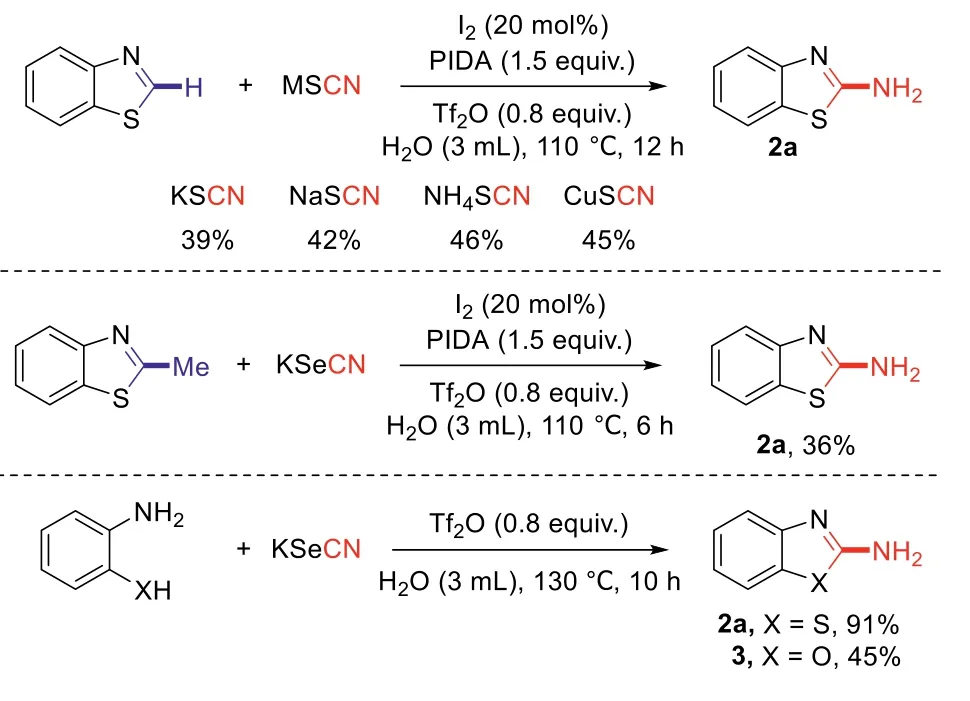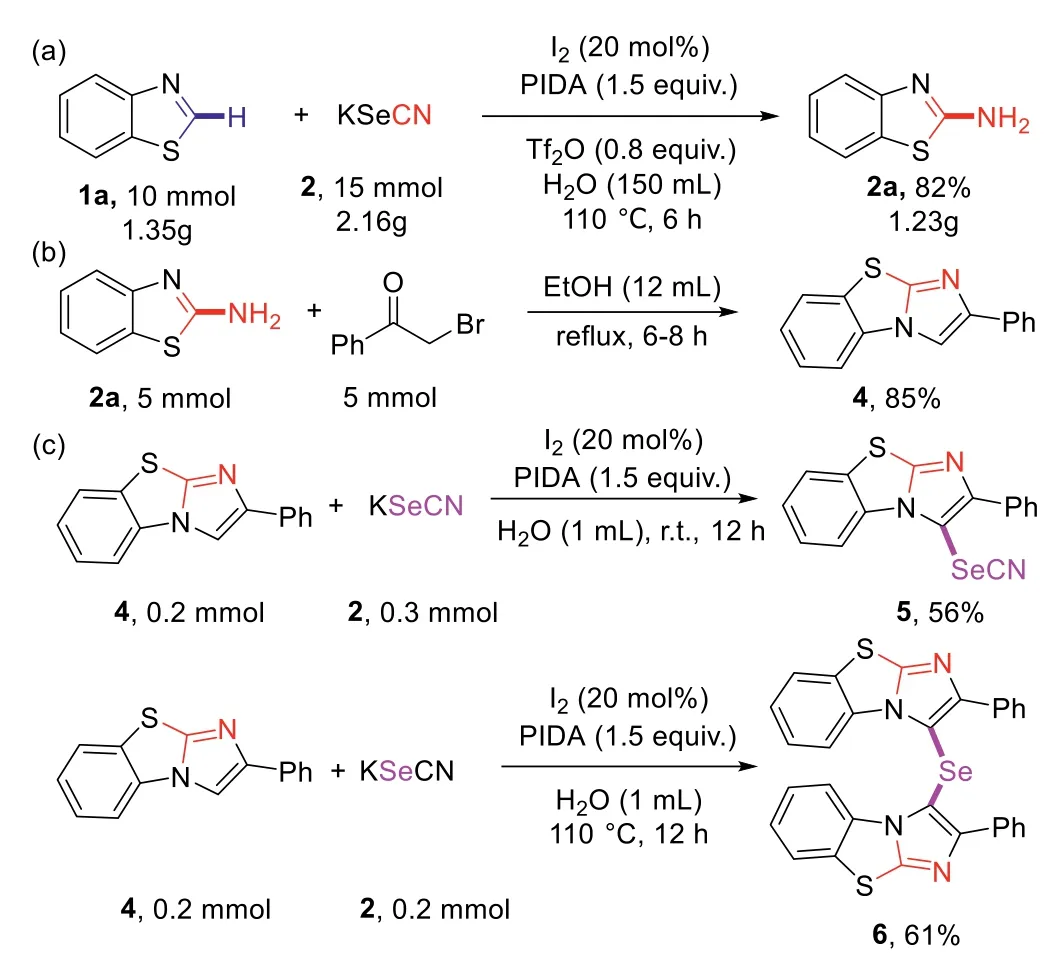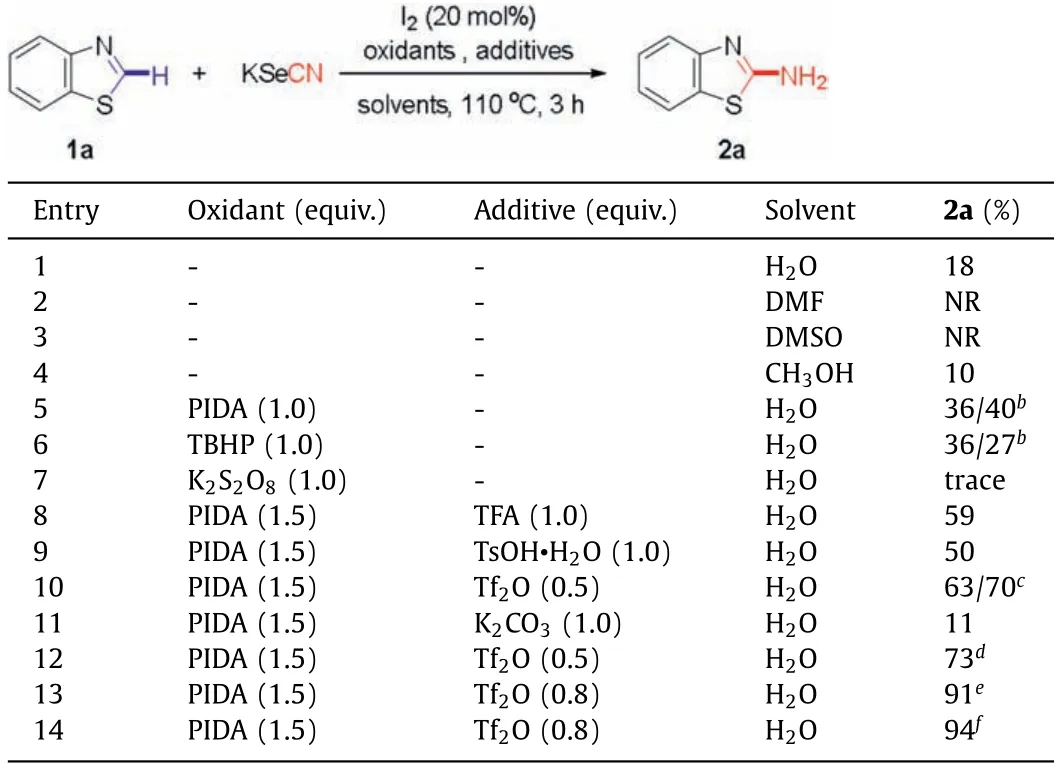Iodine-catalyzed amination of benzothiazoles with KSeCN in water to access primary 2-aminobenzothiazoles
Yu-Shen Zhu,Linlin Shi,Lianrong Fu,Xiran Chen,Xinju Zhu,Xin-Qi Hao,Mao-Ping Song
College of Chemistry,Zhengzhou University,Zhengzhou 450001,China
Keywords:Iodine-catalyzed Benzothiazoles KSeCN Water Primary 2-benzothiazolamines
ABSTRACT A facile and sustainable approach for the amination of benzothiazoles with KSeCN using iodine as the catalyst in water has been disclosed under transition-metal free conditions.The reaction proceeded smoothly to afford various primary 2-amino benzothiazoles in up to 96% yield.A series of control experiments were performed,suggesting a ring-opening mechanism was involved via a radical process.This protocol provides efficient synthesis of primary 2-aminobenzothiazoles
2-Aminobenzothiazoles are important building blocks in organic synthesis [1]with wide applications in pharmaceuticals,agrichemicals,and medicinal science [2–5].Meanwhile,2-aminobenzothiazole derivatives also serve as fluorescent sensor in the detection of metal ions [6].Accordingly,great effort has been made for the synthesis of 2-aminobenzothiazoles [7].The successful approaches include transition-metal-catalyzed tandem condensation and cyclization betweeno-haloaniline and isothiocyanates or other reagents (Scheme 1a) [8–10],intramolecular cyclization ofN-arylthioureas or 2-haloarylthioureas (Scheme 1b) [11–13],and amination of benzothiazoles with amines or formaides (Scheme 1c)[14–19].Recently,cascade reaction between aryl isothiocyanates with amines or formamides has also proved to be an effective strategy (Scheme 1d) [20–24].Despite the above elegant work,the aforementioned protocols mainly focused on synthesis of secondary and tertiary amino-substituted benzothiazoles.Meanwhile,transition-metal catalysts and toxic organic solvents are generally required,which is not environmentally benign.Therefore,it is highly imperative to explore a novel and facile synthetic method to access primary 2-amino-substituted benzothiazoles while meeting green and sustainable chemistry.
Facing the challenge of environmental issues and depletion of nonrenewable resources,the concept of green chemistry and principles has been proposed to reduce chemical waste.Specially,the utilization of green solvents is a key principle in the synthetic community [25,26].As a non-toxic,commercially available,and renewable resource,water has become an excellent reaction medium for organic transformation with improved selectivity,efficiency,and work-up procedures [27–29].On the other hand,selenocyanate potassium (KSeCN) is a cheap readily,and versatile reagent with wide applications in organic chemistry.In general,KSeCN could be utilized as selenocyano sourcevianucleophilic reactions or radical pathways [30–33].Meanwhile,KSeCN has been applied as a selenium transfer reagent [34–37].In our recent work,we have also reported temperature-controlled selenation and selenocyanation of imidazopyridines with KSeCN in water [38].Nevertheless,the employment of KSeCN as the cyano synthon has not been achieved.
In accordance with principles of green chemistry,we have achieved C-H sufonylmethylation of imidazopyridines and indoles in nontoxic media [39,40].We also have reported iodine-mediated C-H sulfonylation and sulfenylation of imidazopyridines under metal-free conditions [41].Recently,Li and co-workers have reported iron-catalyzed arylation of benzothiazoles with aryl aldehydes (Scheme 1e) [42].In view of the increased attention to design green and transition-metal-free methods for the formation of heterocyclic compounds,we herein develop a one-pot synthesis of primary 2-aminobenzothiazoles from benzothiazoles and KSCN through thein-situformation of an aminobenzenethiol intermediate,intermolecular condensation,and cyclization process catalyzed by iodine (Scheme 1f).The advantages of this methodology include nonmetallic catalyst,novel CN source,green reaction media,and operational convenience.
We initiated our studies using benzothiazole 1a (0.2 mmol) and KSeCN (0.2 mmol) as the model substrates in the presence of I2(20 mol%) in water (1 mL).To our delight,the aminated product 2a was obtained in 18% yield at 110 °C for 3 h under air (Table 1,entry 1).Subsequently,various solvents,such as DMF,DMSO,and CH3OH,were investigated,which all gave inferior results (Table 1,entries 2–4).Next,a series of oxidants were screened (Table 1,entries 5–7),indicating addition of PIDA (1.5 equiv.) was beneficial to provide 2a in 40% yield (Table 1,entry 5).To further improve reaction efficiency,different additives were examined,such as TFA,TsOH.H2O,Tf2O,and K2CO3,which gave 2a in up to 70% yield when the reaction was heated for 6 h (Table 1,entry 10).Finally,the molar ratio of reactants and amount of solvent were examined,which gave 2a in up to 94% yield (Table 1,entry 14).The structure of 2a (CCDC No.2034721) was further confirmed by X-ray crystallography analysis (see Supporting information for details).
With the optimized reaction conditions in hand (entry 14,Table 1),the substrate scope of benzothiazoles was investigated(Scheme 2).Initially,4-halogen-substituted benzothiazoles were examined to give products 2b and 2c in 72% and 74% yields,respectively.Subsequently,a series of 5- and 6-substituted benzothiazoles were employed,which reacted with KSeCN to afford the desired products 2d-2q in 17%–96% yields.

Scheme 3.Investigation of “CN” reagents and other substrates.

Scheme 4.Gram-scale reaction and further derivatizations.

Table 1 Optimization of the reaction conditions.a
Especially,benzothiazoles bearing strong electron-withdrawing groups,including NO2and CN,were also well tolerated to give products 2i,2o and 2p in 77%–91% yields.Unfortunately,for 6-hydroxy-substituted benzo-thiazole,the aminated product 2q was isolated in 17% yield.Next,7-bromo and 7-ester substituted benzothiazoles proceedes smoothly to provide aminated products 2rand 2s in 83% and 62% yields.Moreover,for disubstituted benzothiazole,the corresponding products 2t was obtained in 54% yields.Finally,heterocyclic thiazoles were also compatible with the optimized conditions to deliver 2u-2w in 54%–70% yields.
Encouraged by the above results,other thiocyanate salts were also evaluated as the cyano source (Scheme 3) [43–45].Pleasingly,when KSCN,NaSCN,CuSCN,and NH4SCN was employed,the aminated product 2a was isolated in 39%–46% yields.Nevertheless,compared with thiocyanate salts,KSeCN demonstrates superior reactivity,which could be utilized as a novel CN source.Next,2-methylbenzothiazole could also react with KSeCN to afford the desired product 2a in 36% yield.Finally,when aminophenol and aminothiophenol were examined,the desired products 2a and 3[46]could be obtained in 91% and 45% yields,respectively,without I2and PIDA.These promising results enable the current protocol as a reliable and practical procedure to access 2-aminobenzoxazole derivatives.
To demonstrate the synthetic utility of this methodology,a gram-scale reaction was performed to give 2-aminobenzothiazole 2a in 82% yield (Scheme 4).Meanwhile,the obtained 2a could be converted to imidazoheterocycles 4 in 85% yield [47,48],which is difficult to realize from benzothiozole.Moreover,imidazoheterocycles 4 could undergo further functionalizations to afford the corresponding chalcogenated product 5 and chalcogenocyanated product 6 in 56% and 61%,respectively.In this case,KSeCN was utilized as SeCN and Se source selectivity.

Scheme 5.Control experiments.
To explore reaction mechanism,a set of control experiments were conducted (Scheme 5).Initially,1a could be converted to aminothiophenol in 18% yield without KSeCN under standard conditions (Scheme 5a).Aminothiophenol is not stable (decomposed)under the current conditions,which might explain the low isolated yield (Scheme 5b).Meanwhile,both I2and PIDA are required for this transformation.Without I2and PIDA,aminothiophenol could not be generated (Scheme 5a).Next,reaction between aminothiophenol and KSeCN under standard conditions would afford 2a in 29% yield,suggesting aminothiophenol could be an intermediate in the reaction system (Scheme 5c).When the reaction was performed in the absence of I2and PIDA,the aminated product 2a could be obtained in 42% yield.Finally,the radical scavenger reactions were performed (Scheme 5d).In the presence of TEMPO and BQ,the formation of corresponding amino-benzothiazole 2a was substantially depressed,indicating a radical mechanism might be involved.
On the basis of above discussion and relevant literatures,two plausible reaction mechanisms were proposed (Scheme 6) [49–53].In the mechanism A,benzothiazole 1a underwent oxidative ringopening process in the presence of I2and PIDA to give aminothiophenol Ain situ[54],which reacted with KSeCN and Tf2O to afford imine intermediate B.The subsequent intramolecular addition generated intermediate C,followed by aromatization to deliver the aminated product 2a.Alternatively,the iminium species D was initially formed from benzothiazole in the presence of KSeCN and Tf2O [51].Subsequently,nucleophilic attack of iminium D by H2O gave hemiacetal intermediate E [52].Next,the intermediate E underwent ring-opening process to give intermediate F,which produced sulfur radical G through the reaction of PIDA with I2[53].Finally,thioyl radical G underwent tautemerization and annulation process to afford intermediate H,followed by release of TfSe·to give the desired product 2a.

Scheme 6.Proposed mechanism.
In conclusion,we have demonstrated the direct amination of benzoxazoles with KSeCN under transition-metal-free conditions.This methodologly provided efficient access to primary 2-benzothiazolamines using cheap and non-toxic iodine as catalyst and water as reaction media,which is more environmentally friendly.Various functional groups,including OMe,OCF3,F,Cl,Br,COOMe,CN and NO2,and heterocyclic thiazoles were all well tolerated under the optimized conditions.Mechanism studies indicated this transformation proceededviaa ring-opening process.Notably,2-methyl benzothiazole was also compatible to give the corresponding aminated product,which is less reported.This protocol featured with unique characterizations,including transitionmetal free,novel CN reagent,green reaction media,operational convenience,high efficiency,and gram-scale production.
Declaration of competing interest
The authors declare no competing financial interest.
Acknowledgment
Financial support from the National Natural Science Foundation of China (Nos.21672192,21803059,and U1904212) is gratefully appreciated.
Supplementary materials
Supplementary material associated with this article can be found,in the online version,at doi:10.1016/j.cclet.2021.08.070.
 Chinese Chemical Letters2022年3期
Chinese Chemical Letters2022年3期
- Chinese Chemical Letters的其它文章
- Direct catalytic nitrogen oxide removal using thermal,electrical or solar energy
- Construction and applications of DNA-based nanomaterials in cancer therapy
- Recent research progress of bimetallic phosphides-based nanomaterials as cocatalyst for photocatalytic hydrogen evolution
- Nanostructured materials with localized surface plasmon resonance for photocatalysis
- Recent progress of Pd/zeolite as passive NOx adsorber: Adsorption chemistry,structure-performance relationships,challenges and prospects
- Microfluidic methods for cell separation and subsequent analysis
